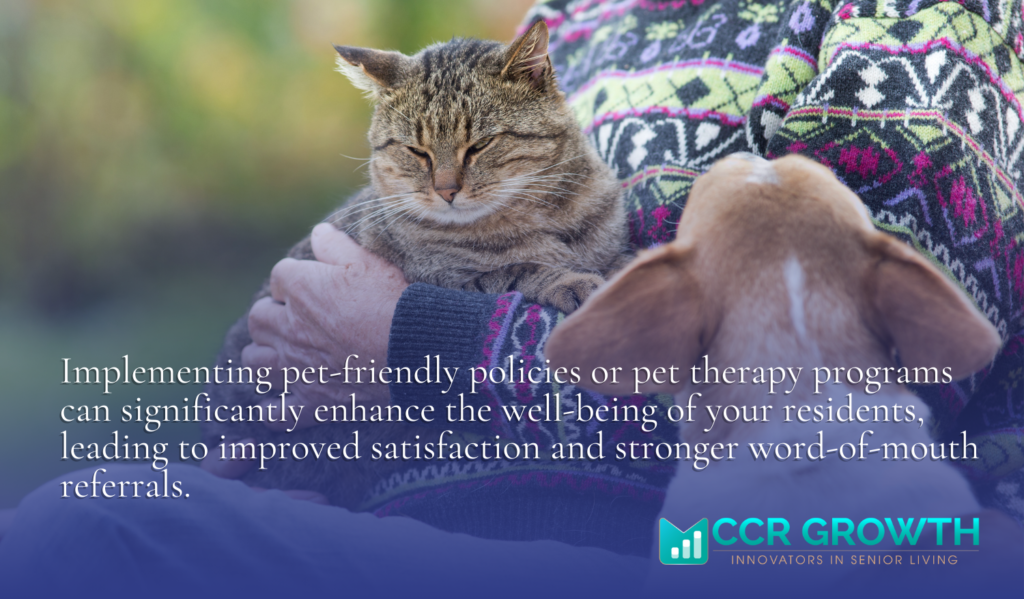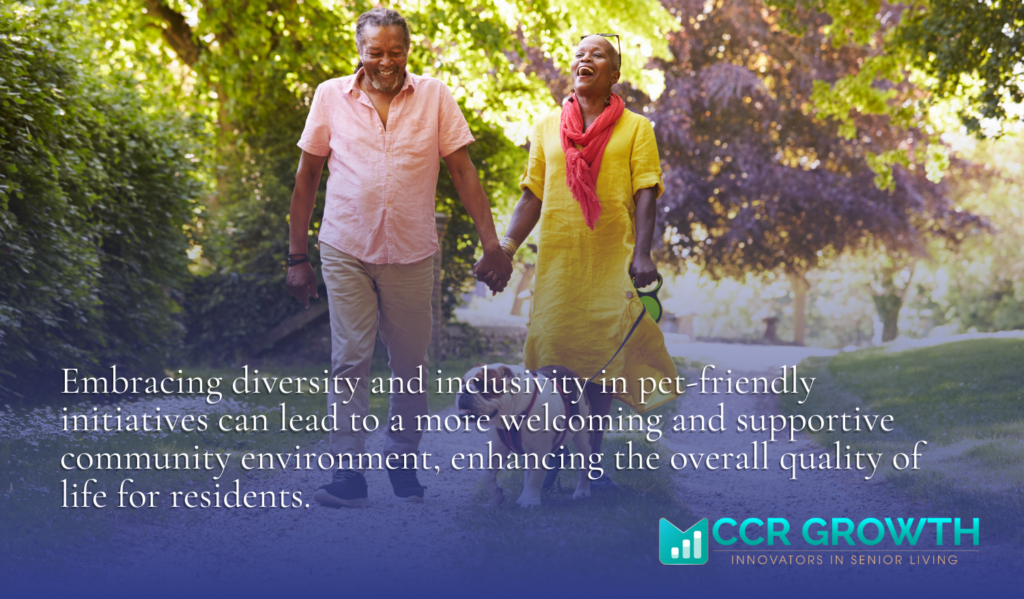
CCR Growth
How Pet Therapy Can Attract Residents and Boost Your Senior Living Community
The bond between humans and animals is profound, offering companionship, comfort, and a sense of purpose. Picture this: a small, furry companion giving unconditional love and companionship to an older adult who has recently lost their life partner, or who has been living alone for years and is seeking a way to combat growing loneliness. Beyond this heartwarming image, there’s a powerful case to be made for integrating pets into senior living communities. It is a strategic tool that can enhance resident satisfaction, attract new residents, and differentiate your community in a crowded market, placing you at the forefront of modern senior living.

Outline
Published on
21/08/2024
Choosing to relocate to a senior living community is rightly considered a major life decision. From the point of view of a potential resident, this decision is made only more complicated if their pet is not welcome in the community of their choice. Helping new residents to adjust to living in your community should involve accommodating their cherished four-legged companion to allow them the best chance of adjusting well.
The Science Behind Loving Pets
Research consistently underscores the therapeutic benefits of human-animal interaction. Evidence strongly supports the positive impact of animal-assisted activities on the well-being of older adults. From reduced stress and anxiety, physiological benefits such as lower blood pressure and stronger immune response, as well as increased socialization, the benefits are clear. For residents with cognitive impairments, such as Alzheimer’s disease, human-animal interaction has shown promise in reducing agitation, improving mood, and enhancing overall quality of life.
How Pets Factor into Senior Living
 You’d be forgiven for thinking that pet ownership might not typically be encouraged in most senior housing establishments. After all, there is an extra layer of management that would be required for ensuring responsible pet ownership for both the pet’s well-being and to ensure that residents who might prefer not to interact with pets are also considered.However, with some careful measures in place, being pet-friendly can create a healthier and happier environment for all – including your staff. In fact, there are several studies that demonstrate that pets in the workplace might improve overall health and well-being for employees. Additionally, there is some evidence to suggest that having pets around might encourage collaboration, openness and overall better communication. Happier staff can only mean one thing: more satisfied residents. Offering pet-friendly accommodations or incorporating pet therapy programs can significantly enhance a senior living community’s appeal to potential residents.By catering to the growing desire for companionship and emotional well-being, senior living communities can attract a new demographic of residents and foster a stronger sense of community. And since pet ownership is associated with more activity, you may even find your residents remain active and healthy for longer.
You’d be forgiven for thinking that pet ownership might not typically be encouraged in most senior housing establishments. After all, there is an extra layer of management that would be required for ensuring responsible pet ownership for both the pet’s well-being and to ensure that residents who might prefer not to interact with pets are also considered.However, with some careful measures in place, being pet-friendly can create a healthier and happier environment for all – including your staff. In fact, there are several studies that demonstrate that pets in the workplace might improve overall health and well-being for employees. Additionally, there is some evidence to suggest that having pets around might encourage collaboration, openness and overall better communication. Happier staff can only mean one thing: more satisfied residents. Offering pet-friendly accommodations or incorporating pet therapy programs can significantly enhance a senior living community’s appeal to potential residents.By catering to the growing desire for companionship and emotional well-being, senior living communities can attract a new demographic of residents and foster a stronger sense of community. And since pet ownership is associated with more activity, you may even find your residents remain active and healthy for longer.Implementing a Successful Pet Therapy Program
Where pet ownership is not possible, senior living communities might consider offering pet therapy as an option to give residents in senior care the opportunity to interact with furry friends. Not only can interaction with pets in this way improve resident health, wellbeing and overall satisfaction, but pet therapy might also lead to higher occupancy rates and positive word-of-mouth referrals. Not to mention that the heartwarming stories and visuals associated with pet therapy can be powerful marketing tools, differentiating your community from competitors.

Pet therapy may look different depending on what resources are available to your community. One innovative way of incorporating pets into your community is by involving your local town in a pet therapy program. To ensure pets are trained to interact calmly in a senior care environment, you might require that all participating pets pass the American Kennel Club’s Canine Good Citizens course, a 10-skill test to train pets and owners who can safely and responsibly interact in your senior living environment. Consider inviting local town members whose pets are Canine Good Citizens to visit your community and interact with residents on a regular basis. To maximize the benefits of pet therapy, careful planning is essential. Consider partnering with reputable animal therapy organizations to ensure the well-being of both animals and residents. Proper training for staff and residents is also vital. By creating a pet-friendly environment, offering opportunities for interaction, and addressing potential challenges such as allergies, you can successfully implement a pet therapy program that enriches the lives of your residents and strengthens your community’s reputation.
Wrap-Up
The integration of pets into senior living communities is a win-win proposition. By prioritizing the emotional and social well-being of residents, you can create a more fulfilling and engaging living environment while also boosting your community’s reputation and bottom line. At CCR Growth Agency we help Senior Living communities find their unique marketable qualities and generate highly qualified leads through holistic marketing strategies. Get in touch to discuss your Senior Living marketing strategy and community growth.
Subscribe to our newsletter
Sharpen your expertise and stay ahead of senior living industry trends—subscribe to CCR Growth’s newsletter for exclusive insights and updates.
Recent Posts


Google Ads vs. Facebook Ads: Which Works Best for Retirement Communities?

Proud Members of:

Redefining Senior Living Marketing, Sales, and Operations
CONTACT ADDRESS
8710 Carmel Valley Road, Carmel, CA 93923
GENERAL INQUIRIES
info@ccrgrowth.com
(831) 273-3628
SOCIAL MEDIA




